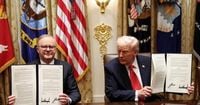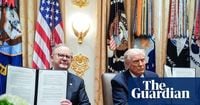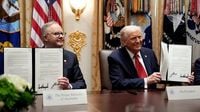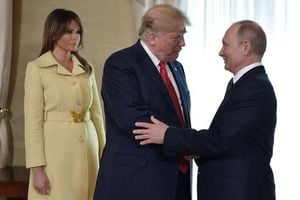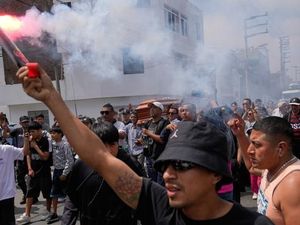On Monday, October 20, 2025, the White House played host to a pivotal moment in the global race for critical minerals. U.S. President Donald Trump and Australian Prime Minister Anthony Albanese signed an $8.5 billion agreement designed to supercharge the supply of rare earths and other essential minerals, setting the stage for a dramatic shift in the world’s resource landscape.
The deal, coming on the heels of China’s announcement of tougher export controls on rare earths, is widely viewed as a strategic maneuver to reduce Western dependence on Beijing for materials crucial to everything from smartphones and electric vehicles to advanced military systems. According to NBC, China currently accounts for roughly 60% of the world’s rare earth production—a dominance that U.S. officials have repeatedly flagged as a strategic vulnerability, especially as the clean energy transition accelerates.
“The formation of global production and supply chains is the result of market and corporate choices,” stated Guo Jiakun, spokesperson for China’s Ministry of Foreign Affairs, as reported by NBC. He emphasized that “resource-rich nations with critical minerals should play a proactive role in safeguarding the security and stability of the industrial and supply chains, and ensure normal economic and trade cooperation.”
But the timing of the U.S.-Australia pact was no accident. Earlier in October, China’s Commerce Ministry expanded curbs on rare earth exports and related technologies, citing the need to prevent their “misuse” in military and sensitive sectors. The move sent shockwaves through Western industry groups, particularly in automotive manufacturing, who warned of potential supply chain chaos if alternative sources weren’t secured.
The new agreement is ambitious in scope. Both the U.S. and Australia pledged to invest $1 billion each over the next six months into mining and processing projects. These initiatives are split across three categories: joint U.S.-Australia ventures, projects solely in Australia, and collaborative efforts with Japan. The framework even includes a minimum price floor for critical minerals and a commitment to streamline permitting for mines and processing facilities—an often-overlooked bottleneck in getting new resources to market, according to a White House document cited by FOX Business.
Australian Prime Minister Albanese described the plan as an $8.5 billion pipeline “that we have ready to go,” while President Trump exuded confidence, telling reporters, “In about a year from now, we’ll have so much critical mineral and rare earths that you won’t know what to do with them.”
Yet, as The New York Times points out, the path from mine to market is anything but straightforward. “Finding geological deposits of rare earths is just the start. Obtaining permits for a new mine is often time-consuming, and then building a mine can take several years. Setting up a refinery to separate rare earths from ore also takes years,” the outlet reported. The chemical processes required are notoriously complex, and the environmental challenges are significant. It’s no wonder private companies often hesitate to invest in such a specialized, low-margin sector without government backing.
Australia, for its part, brings substantial resources to the table. The country holds at least 5% of the world’s rare earth reserves and is responsible for about 8% of global production, according to The New York Times. It also boasts 89 active rare earth exploration projects—more than any other nation, as highlighted by the Center for Strategic and International Studies. Two major projects have already been announced: a rare earths mine in the Northern Territory expected to contribute up to 5% of global supply, and a gallium project in Western Australia projected to eventually produce a tenth of the world’s gallium, a metal vital for specialized semiconductors.
But even as Australia and the U.S. move to break China’s stranglehold, the economic ties between Canberra and Beijing remain deep. China buys a third of all Australian exports—mainly iron ore, coal, wine, and beef—and accounts for three-quarters of Australia’s iron ore shipments. In late September, Chinese state media warned Australia about its security cooperation with the U.S., declaring it would not tolerate “infringements on its core interests.”
In the immediate aftermath of the deal, markets responded with typical volatility. Shares of Australian rare earth companies fluctuated sharply: Lynas Rare Earths fell 7.6% after early gains, Iluka Resources slipped 0.1%, Pilbara Minerals rose 2.6%, and Latrobe Magnesium soared by more than 15%. Meanwhile, U.S.-listed rare earth stocks edged lower in premarket trading, with Critical Metals down 3.8%, USA Rare Earth off 5%, and MP Materials losing 1.9%, according to CNBC.
Beyond the minerals pact, the summit also touched on broader security issues. President Trump reiterated his support for the AUKUS trilateral security partnership, which includes a plan for the U.S. to sell Australia nuclear-powered submarines by 2032—a deal first negotiated under President Joe Biden. Australia is expected to spend a staggering $239 billion over three decades on this new submarine class, which will eventually be built in partnership with the UK. Security experts have closely watched developments around AUKUS, given fears that a change in U.S. political winds could put the deal in jeopardy. “We have them moving very, very quickly,” Trump said of the submarine arrangement.
The day’s events weren’t all business, however. In a moment that drew attention from both sides of the Pacific, President Trump engaged in an awkward exchange with Kevin Rudd, Australia’s ambassador to the U.S. and a former prime minister. When asked by an Australian reporter if Rudd’s past criticism of him affected his view of the Albanese administration, Trump replied, “I don’t like you either. And I probably never will.” Rudd, for his part, responded with characteristic candor: “Before I took this position, Mr. President.” The moment underscored the sometimes-personal nature of international diplomacy, even as both nations pursue shared strategic goals.
Industry analysts remain cautious about the immediate economic impact of the rare earths deal. George Cheveley, a natural resources portfolio manager at Ninety One, told CNBC that while the agreement is “a good deal” from a strategic perspective, “it is not so obvious” from an investment standpoint. “This is a very small sector. And clearly when you’re dealing with a sector so politicized and where government money is being put in essentially as a subsidy, it is telling you that it is difficult to make it work economically.”
Despite the challenges, the U.S.-Australia pact represents a bold attempt to reshape the global critical minerals landscape—one that could have ripple effects for years to come as nations vie for the resources powering the technologies of the future.
